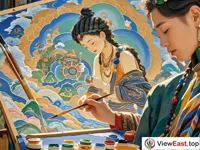
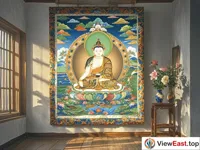
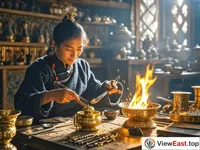
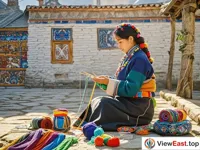
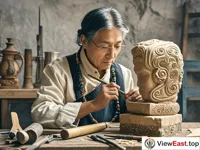


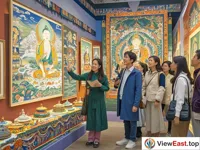
Tibetan Thangka art and handicrafts are integral components of Tibetan culture, representing not just an artistic form but also a cultural heritage and embodiment of the national spirit. This article will introduce Tibetan Thangka art and handicrafts from multiple dimensions, showcasing their rich and colorful life content and profound cultural heritage.
I. The Charm of Thangka Art
Thangka is a unique painting art form in Tibetan culture, known for its meticulous craftsmanship and profound religious connotations:
Religious Significance: Thangkas typically depict Buddhist stories or deities, representing an essential aspect of Tibetan people's religious beliefs.
Artistic Style: Thangka art is famous for its vivid colors, delicate lines, and intricate compositions, possessing high artistic value.
Craftsmanship: The creation process of Thangkas is very complex, including drawing, coloring, gilding, and other steps, each requiring exceptional skill and patience.
II. The Inheritance of Handicrafts
Tibetan handicrafts are also rich and diverse, reflecting the wisdom and creativity of the Tibetan people:
Gold and Silverware: Tibetan gold and silverware craftsmanship is exquisite, often used for religious artifacts and daily life items.
Weaving and Embroidery: Tibetan weaving and embroidery also have a long history, with products featuring bright colors and diverse patterns.
Wood and Stone Carving: Tibetan wood and stone carving skills are superb, with works often having high artistic and collection value.
III. The Integration of Culture and Life
Tibetan Thangka art and handicrafts hold significant positions not only in religious and artistic fields but also deeply integrate into the daily lives of Tibetan people:
Home Decoration: Thangkas and handicrafts are often used for home decoration, adding a cultural atmosphere to households.
Festival Celebrations: In Tibetan festival celebrations, Thangkas and handicrafts are indispensable decorative elements.
Social Interaction: Tibetan handicrafts are also an essential medium in social interactions, often given as gifts to friends and relatives.
IV. Modern Impact
With the development of the times, Tibetan Thangka art and handicrafts continue to inherit and innovate:
Cultural Protection: Governments and cultural institutions are committed to protecting and inheriting Tibetan Thangka art and handicrafts to prevent their loss.
Artistic Innovation: Artists explore modern expressions of Thangka art and handicrafts while maintaining traditional skills.
Tourism Promotion: Tibetan Thangka art and handicrafts have also become important cultural resources to attract tourists, promoting the development of local tourism.
V. Conclusion
Tibetan Thangka art and handicrafts are treasures of Tibetan culture, showcasing the life emotions of Tibetan people and being an integral part of the multicultural fabric of China.